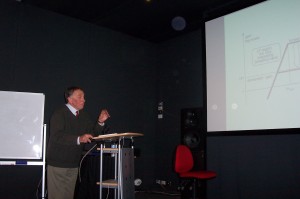On Wednesday June 3rd twenty-four AES members and visitors gathered at the SAE Institute Lecture Theatre in South Melbourne to hear renowned designer Ed Cherry present a talk on
“Feedback and Distortion in Audio Amplifiers”
Ed started his presentation by outlining the early years at Bell Labs, where Ed later worked, where the impetus to reducing distortion (particularly of the intermod variety) was to improve the audio-channel carrying capacity of their existing copper wire network (which comprised 50% of their capital assets) by multiplexing signals without the limitations of interference from intermodulation products.
He recounted how Harold Black first conceived the principle of negative feedback in 1927, on a ferry from New Jersey to his New York workplace, Bell Labs – sketching the principles on a blank area of his New York Times newspaper.
Ed then went on to describe the principles of negative feedback, as applied to amplifier design in general. He described various methodologies, taking into account issues of stability, loop gain, phase shift, and frequency response – and how the principles applied universally to valve (tube), bipolar transistor and FET active devices.
Ed then presented a 60watt amplifier of his own design to demonstrate the design principles to eliminate many of the distortion effects.
Ed cleared up two misunderstandings that arose regarding such ideas as transient intermodulation distortion, more appropriately described as slew rate limiting, and interface intermodulation distortion better described as an amplifier output impedance effect.
Then to round off the evening Ed presented a proposal for testing for Intermodulation Distortion in audio amplifiers which he has developed with Greg Cambrell. It involves presenting a single resistive load of value Root 2 https://s3-ap-southeast-2.amazonaws.com/aesmel/AES+Audinate+final.mp3of the nominal load resistance across the L & R outputs of a stereo amplifier and driving the L & R inputs with 5F and 7F respectively.
He described how an oscilloscope lissajous pattern can be derived from the output load which can accurately describe the amplifier performance.
His presentation was followed by a question and answer period where much interest was shown in his design decisions and methods.
The video below is Ed’s slides sync’ed with the audio recording:
The slides alone can be viewed or downloaded here
-and-
The audio recording can be played or downloaded here
Thanks to Graham Haynes and his trusty Tascam for the audio recording.
A special thanks to the SAE Institute and Andrew Broadhead for the use of their facilities for this meeting.

